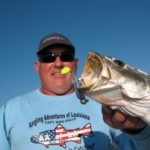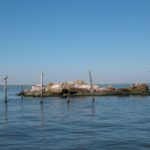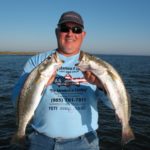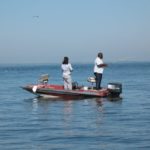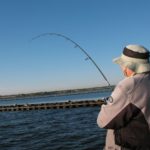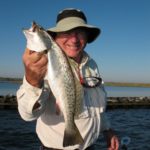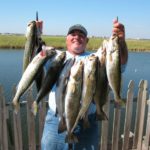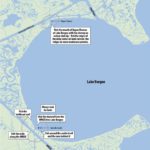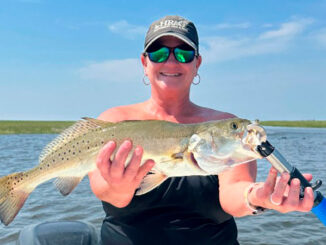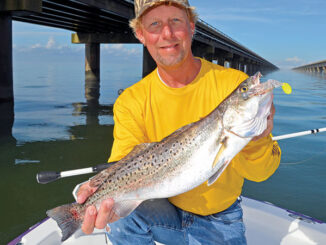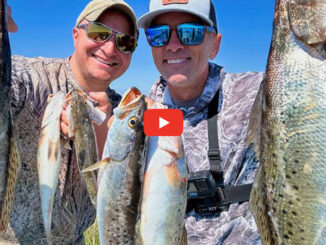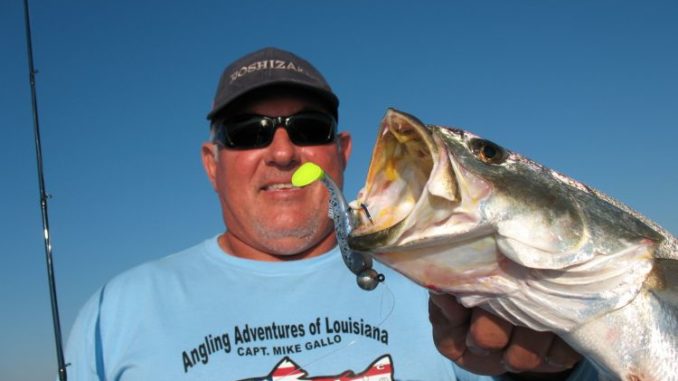
Speckled trout and reds roam the old ruins of what for decades was known as ‘The Castle.’ So take some tips from this guide and catch your fill.
I grew up in St. Bernard Parish, and often launched my flatboat at the old Depope boat launch in Violet and fished the ancient tower we simply called, “The Castle” — or as it was sometimes referred to, the “Martello Castle.”
Even back then I knew it had a long history, but the history didn’t interest me as much as the trout that congregated in the area, especially in the spring and fall.
We made more than a few great trips out there, back in the day.
Fast forward to a fairly recent vacation I took to Canada, during which I found that one of the attractions in Saint John, New Brunswick, was called “Martello Tower.”
With just a little research, I learned that more than 100 Martello Towers were built all over the coastline of Great Britain and Ireland to keep Napolean’s fleet from invading.
The towers — about 40 feet tall, thick-walled and round to deflect cannon balls — were copied from the original built at Martella Point on the island of Corsica.
Martella became Martello, and all the towers henceforth bore that designation. Each was generally equipped with a single canon that could swing 360 degrees on the flat roof and a garrison of 15 to 25 men.
Here in the US, after the war of 1812 and our defeat of the British, Americanized versions of the Martello Towers were ordered built by President Andrew Jackson in several vulnerable points of egress to New Orleans as part of the fortifications intended to prevent another invasion by the Brits or anyone else.
The “Castle” we fish in Lake Borgne was constructed about 1830, was hexagonal in shape, was equipped with five guns and was technically named Tower Dupre.
But, according to St. Bernard Parish Historical Society’s Anthony A. “Tony” Fernandez, the Tower never saw any action.
The Tower was abandoned in 1883 and eventually sold to a private owner when the government sold off what they deemed surplus property.
It was originally built 150 feet from the water, but erosion quickly absorbed the land all around it and it stood like a silent sentinel surrounded by water for more than a century.
It was used as a fishing camp for years, but the battering of numerous hurricanes took an eventual toll, and in 2005 a wicked witch named Katrina did what no cannon could — reduce the once proud tower to a pile of rubble.
But the fish still congregate around it, and Capt. Mike Gallo often makes the run from his camp in the Rigolets this time of year to put some trout on ice.
I asked Gallo specifically to take me there, since I’ve scarcely fished it since Katrina, and he willingly obliged. I brought along a good friend and deacon at our church, Bob Mercer, and met Gallo at his camp at sunup.
Gallo had his Uncle Dan Couvillion with him, and after we all piled aboard his 24-foot bay boat, he pointed the bow toward Lake Borgne.
The conditions couldn’t have been better. Winds and seas were light, the tide was high and falling, and the boat ride across the northeast point of Lake Pontchartrain through Pass Rigolets and into Lake Borgne was smooth and pleasant.
Gallo knew our destination was the Castle, but he just couldn’t pass up the cut at Bayou Thomas.
“It’s been on right here the past week or so,” he said. “We’ve been fishing live shrimp on a drop-shot rig, and the trout have been smacking them hard like you expect them to hit during the summer.”
Several boats were already there when we idled in, so I knew the word was out.
“The water is deep here, up to 40 to 45 feet deep, and when the current is moving hard it can be difficult to anchor,” Gallo said. “I look at the current, and if it’s moving hard and fast I look for eddies and anchor off to the side and fish the edges. And if it’s moving slow, I’ll fish the middle of the channel.
“I typically use a 3/8- or ½ ounce weight, but never less than 3/8 ounce.”
He always wants some tidal flow.
“People always ask me what I prefer to fish: an incoming tide or a falling tide,” Gallo said. “Basically, I like an incoming tide in the spring and a falling tide in the fall — but the fact is, as long as you have moving water, you can catch fish.
“My No. 1 rule is don’t fish dead water.”
But the trout must have bypassed Bayou Thomas that morning, because we fished all around the boat and gave the spot plenty enough time to produce. After 20 minutes or so without as much as a nibble, we left.
I could tell Gallo was reluctant to leave simply because the fish had been stacked up there the previous week, and the action had been consistent day after day. It makes you want to sit there awhile and see if they’ll just start up.
But you have to weigh sitting and waiting for action you hope will start against running elsewhere and trying other potentially productive spots.
The latter option won, and we headed for our original target: the rock pile formerly known as Tower Dupre.
As we approached, I counted more than 20 boats fishing all around the Castle area.
Many were surrounding the castle-now-turned-rock pile itself, and others were fishing along the bulkhead on the right side of our approach from the lake.
Others were positioned on both sides of the deeper channel stretching from the MRGO past the former tower into Lake Borgne, and quite a few were spread out seemingly haphazardly a distance behind the Castle.
“Twenty boats, and this is a Monday,” I said.
“You ought to see it on weekends: When the fish are biting, it can be like a parking lot,” Gallo said.
Parking lot or not, I saw people in practically every boat heaving fish over the gunnel.
It wasn’t what I’d call fast and furious action, but steady. Everybody seemed to be catching fish.
The trout were definitely there, and in large quantities.
The birds were the most visible giveaway. I saw concentrations of more seagulls swarming and diving over shrimp and squawking in that area than I ever remember seeing anywhere before in one place.
If I said there were thousands of birds diving, it would not be an exaggeration.
I guess it was the perfect conflux of conditions. If you fish long enough and often enough, you hope to eventually happen upon a day like it, when everything is perfect: wind, seas, tide, current, bait and trout, all converging at one time in one area.
Gallo calls it a “Community Fishing Hole” because it’s a well-known spot, it’s easy to find, easy to fish and it’s easy to get to.
Gallo ignored the rock pile itself and idled to a spot along the bulkhead. Four or five boats were strung out along the length of the wall and, even from that distance, I could see bent rods in the hands of those nearest the MRGO — and from the arch in their poles they had to be nice-sized fish.
“There are many good places to fish out here, and all of them have the potential to produce fish,” Gallo said.
He pointed out the numerous boats anchored along the deep channel running from the MRGO into Lake Borgne. The channel is marked with markers to guide larger craft from the MRGO safely past the rubble of Tower Dupre into the lake.
“Both sides of that channel are good places to fish drop-shot rigs with live shrimp,” Gallo said. “Those ledges hold some nice trout, and so does this bulkhead wall.”
But bring plenty of tackle.
“It’s 6 to 8 feet deep right here, and the bottom is littered with rocks, so you’re likely to lose some tackle,” Gallo said. “Consider it the price of admission.
“The technique here is to stop letting line out when you feel your weight tap the top of the rocks on the bottom. If you keep letting out line you have a greater chance of snagging bottom.”
We anchored there awhile and, just as the captain predicted, I had to re-tie again and again as I snagged bottom and had to break off my line.
Meanwhile Gallo put a couple of 20-inch trout in the boat.
When the action petered out, he upped the anchor and trolled the back end of the bulkhead where no other boats were parked.
Using the same technique, we boated at least half a dozen very nice trout — all between 20 and 22 inches — before the action played out.
When we first arrived, several boats were fishing close to the Castle and others were off behind it quite a distance.
Gallo said proper positioning is a matter of tidal flow: When the tide is moving hard you can fish as far as a quarter of a mile behind the Castle and catch trout.
“The whole bottom around here is hard bottom, and it holds fish,” he said.
The boats closest to the Castle had moved away, and Gallo crept in close with the trolling motor.
We switched to tight-lining or cork rigs. The action started instantly, and virtually every cast got nailed by a trout.
The specks closest to the Castle weren’t as big as the ones we caught along the bulkhead, but they were all 13 to 14 inches, and they hit anything we threw in the water.
We switched to plastic and the action never slowed. I thought for sure we’d have our space invaded by other boaters seeing us into that much action, but everybody else seemed to be getting similar action where they were.
It was that kind of a day.
Gallo said he obviously can’t guarantee action like that on every trip, but the area does produce with consistency.
“Like anyplace else, there are good days and bad ones,” he said. “You can have a terrific day or a terrible one. There are good months and fair months.
“The better months out here are spring and fall. April and May, October and November, being my favorites, but it’s worth a try almost any time.”
It’s a matter of locating the hot spot on any given day.
“Just don’t think that you have to focus all your attention right around the Castle,” Gallo said. “Fish the bulkhead, fish both sides of the channel, fish off behind the Castle and fish the rocks right up there along the MRGO. I pull some beautiful trout off those rocks sometimes.
And on those tough, windy days, try the locks at the Violet Canal. A drop-shot rig loaded with live shrimp can produce an interesting grab bag of fish, from trout, reds, black drum, sheepshead, bass and freshwater catfish.
“And anytime you come fish out here, look for birds. They’ll lead you right to the fish.”
Editor’s note: Capt. Mike Gallo can be reached at 504-259-3474.
